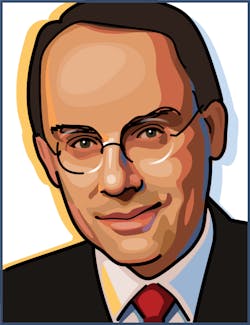IMAGE: “You can compare it to shining a laser pointer onto letters mounted on a groove board … The number of letters on the groove board determines the amount of information you can transmit with the light,” says Pepijn Pinkse, one of the researchers involved. (Photo courtesy of University of Twente.)
Optical signals have a long tradition in communication. In former times, flags or semaphores were used for the first optical telegraph lines. French conqueror Napoleon Bonaparte even carried a portable semaphore station for communication with his headquarters.
Nowadays, it is quantum cryptography that sparks the fantasy of civil and military communication experts. It uses twinned photons and offers a solution to a problem that was connected to optical signal transmission throughout time: How to make sure no one else reads your message before or beside you?
But the key in quantum communication is its main problem. It uses single photons for communication. It’s a fragile spark of light. And it is tough to encode much information in it, not to mention reading it.
Now a Dutch research team has developed a setup to transmit a substantial amount of information on a precious photon. They showed experimentally that they can encode 9,072 different characters using wavefront features of one photon. That is not so different from that first French semaphore, which covered 8,464 different signs in its code.
Steering the photon to the code board
The team from University of Twente used a special kind of spatial encoding: They sent a photon onto a spatial light modulator (SLM) that can steer the horizontal and vertical direction of the photon’s wavefront. A subsequent lens made the beam parallel to the optical axis again, and after some free space transmission the photon was recorded by intensified CCD camera. The position on the camera corresponds to the steering angle of the SLM. By binning 8 x 8 pixels of the camera to one addressable area they could address 112 x 81 such areas on the camera. Associating those areas with symbols of an alphabet would deliver a choice of 9,072 characters for each single photon.
“You can compare it to shining a laser pointer onto letters mounted on a groove board. The illuminated letter is the information contained in the laser pointer’s light. The number of letters on the groove board determines the amount of information you can transmit with the light,” explains Prof. Pepijn Pinkse, one of the researchers involved.
Seeing light in the dark
The major challenge when handling single photons are the losses on the various optical components. One of the entangled photons went through a fiber (47% throughput) to the encoding setup. There, the blazed grating on the SLM had a diffraction efficiency of 76%. After a lens and a bandpass filter the photon arrived at the camera with a photocathode quantum efficiency of 5%.
When 300 years ago the semaphore engineers could not get enough signal at night they finally gave up. We have more sophisticated science and, in particular, statistics.
The biggest problem was camera noise. So the team used the second photon as herald and opened the gate of the camera for only 2 ns. Furthermore, they also applied an energy gate to distinguish photon signals from readout noise and residual gas atoms crashing into the micro channel plate.
But finally, they applied low-density parity-check code, a coding procedure used in digital television broadcasting. This error-correction code allowed a practically error-free communication with the present system.
And whats next?
One could ask why they used the SLM and not a simple scanner? The SLM is the more flexible tool--it could correct for phase disturbances. And in a more complex setup they could manipulate not only the phase but also the amplitude and, hence, create holographic encoding with much more complex wavefronts.
Much of the limitation at the moment is in the camera, and there one could go from 5 to 30% quantum efficiency with different cathode materials. In addition, so far, the technique uses free space transmission. As soon as one can overcome the scrambling of wavefronts in multimode fibers, a new era of secure communication will dawn.

